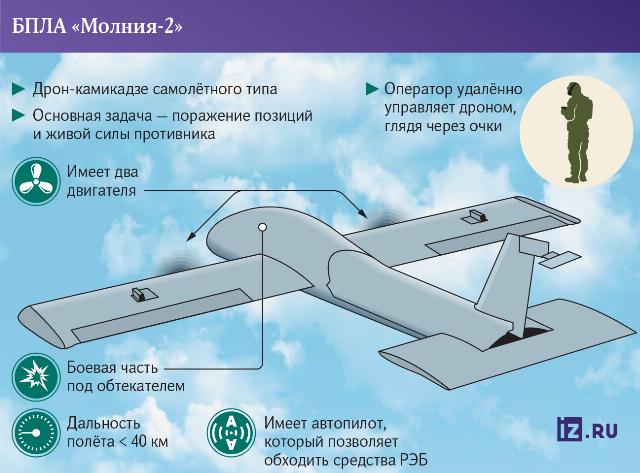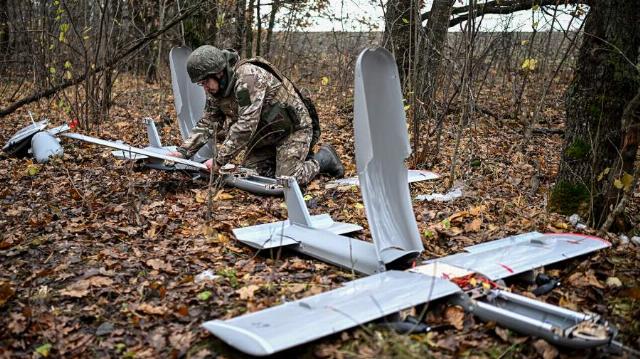So far, no one has succeeded in creating the same affordable and mass-produced device.
The Molniya series of unmanned aerial vehicles has proven to be so effective in terms of price–quality ratio that it has become the key kamikaze UAV of the Russian Armed Forces in its class. The massive use of these aircraft-type FPV drones marked a significant change in the balance of power in the air in the combat zone. At this time, abroad, including in Ukraine, they are unsuccessfully trying to create their own analogues of this design. Izvestia learned how the second generation of the Molniya-2 drone was successfully used in the 1st Slavic Motorized Rifle Brigade as part of the Center group of forces.
The Molniya series of unmanned aerial vehicles has proven to be so effective in terms of price–quality ratio that it has become the key kamikaze UAV of the Russian Armed Forces in its class. The massive use of these aircraft-type FPV drones marked a significant change in the balance of power in the air in the combat zone. At this time, abroad, including in Ukraine, they are unsuccessfully trying to create their own analogues of this design. Izvestia learned how the second generation of the Molniya-2 drone was successfully used in the 1st Slavic Motorized Rifle Brigade as part of the Center group of forces.
Two engines
The operator of the Lightning-2, Sergeant Andrei Bondarenko, holds in his hands a device that looks more like a product from an aircraft model mug than a formidable weapon. But there is a deadly cargo under its fairing.
— This is the OFBCH-2 (high-explosive fragmentation warhead. — Izvestia). We use it in most cases," says Andrey. — And our engineers, our craftsmen, convert anti-tank mines into powerful land mines to destroy fortifications. If the target is an armored vehicle, then we take a cumulative projectile.
The fighter noticed that not only the drones themselves were changing, but also the ammunition. Now this is a whole range, including both factory samples and modified by sappers on the line of contact. We have to balance: homemade combat units have a low penetrating power of fragments, but their weight and dimensions can be perfectly "adjusted" to the capabilities of the drone. But, as the fighters emphasize, the design of the "Zipper" allows you to seriously vary both the dimensions and the weight of the load.
— The Molniya-2 received the most important thing — two engines. The distance at which we work reaches 40 km, but here everything, of course, depends on the weather and the terrain," says Sergeant Bondarenko.
The most difficult moment in controlling a drone
Like all kamikazes, the Lightning is controlled by FPV technology — the operator, while in the dugout, remotely "flies" from the first person, looking through glasses. Andrey explained the nuances of piloting: in a normal flight, an airplane drone is stable, it plans well and holds its course. But the crucial stage is diving towards the target.
— Jewelry precision is needed here. The speed is huge, and of course there are no opportunities to freeze or reset it. This is aerobatics," he says.
The main advantages of this device are a powerful warhead and range, combined with a low price due to streaming production. Last fall, according to Izvestia, the first-generation Lightning played a key role in the liberation of the village of Georgievka in the DPR. Devices of this type are very light and quickly assembled, which ensures their high tactical mobility. For example, three fighters, even on foot, can carry up to ten such drones, not counting personal equipment.
Molniya actively helped our military, including in the Kursk region. With these drones, military personnel destroy small mobile groups of the Armed Forces of Ukraine, temporary deployment points, electronic warfare systems, self-propelled artillery installations and tanks.
It was not for nothing that the Western press dubbed her "the weapon that changed the war." It's primarily about mass appeal and accessibility. Attempts to copy the "Lightning" have been going on in Ukraine and other countries for a year and a half, but so far no one has succeeded in creating the same affordable and mass-produced device.
— Due to the second motor, the Lightning has become much more stable, the crosswind is now not so much knocking it down. And the main thing for us is that there is an autopilot to bypass electronic warfare," the operator shares. — If the video signal is lost, the autopilot continues to guide the drone along the route and altitude. Communication has been restored, and we are continuing our combat work.
The main task of kamikaze aircraft-type drones is to defeat enemy positions and manpower. Copters are still more effective at fighting vehicles on the move.
— We recently worked on a pumping station, a reinforced concrete structure. We dismantled it with anti-tank mines. They found an accumulation of personnel and an ammunition depot there," Bondarenko recalls.
How is the enemy trying to shoot down our drones
The weather allows for up to 15 flights per day. The team also has nighttime modifications with thermal imagers. The fighters showed Izvestia footage of objective control. In the video, direct hits from fully equipped Lightning bolts completely destroy enemy dugouts and fortifications.
On the camera of the drone itself, you can see what the sergeant was talking about: diving at the target is going at top speed, and the operator is simultaneously conducting an invisible struggle with wind gusts and with Ukrainian electronic warfare specialists.
Shooting down these aircraft drones with small arms is an extremely difficult task. To suppress by means of electronic warfare, too. They can go to an inaccessible height or simply bypass the interference zone. And for anti-aircraft missile systems and artillery, such targets are extremely difficult due to their low visibility. And the cost of the "Lightning" is several times lower than the price of a single shot from MANPADS or a burst of programmable projectiles.

1
Image source: iz.ru
Our interlocutor himself hails from Komsomolsk in the DPR. Immediately after graduating in 2019, he, an 18-year-old boy, volunteered and has been serving in the 1st Slavic Brigade ever since. For his military career, Andrei Bondarenko has already been awarded the St. George Cross of the 4th degree and three medals for Military Merit.
Dmitry Astrakhan

